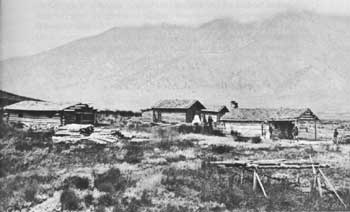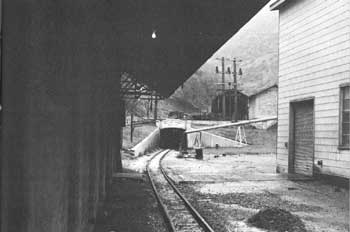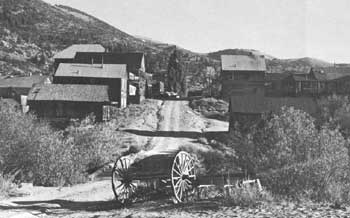






Survey of Historic Sites and Buildings
 |
BOISE Idaho |
 |
| ||
Boise, although never a mining camp, grew up as a result of mining activity in the region and became an important supply and agricultural center. It was originally known as Boise City. When prospectors discovered gold on the Clearwater River in 1860, miners rushed to Idaho country. Subsequent discoveries on the Salmon River and in the Boise Basin attracted more than 25,000 miners and created a great demand for agricultural produce. Boise, established in 1863 adjacent to Fort Boise, met this demand with irrigated farming and became a trading center.
Boise contains several excellent examples of pioneer homes, including the Coston, Pearce, and O'Farrell cabins. Also of interest are Fort Boise, Spanish Village, and the Stone Blockhouse. The United States Assay Office, built in 1870-71, is a Registered National Historic Landmark.
 |
CRAIG DONATION LAND CLAIM (part of Nez Perce National Historical Park) Idaho |
 |
| ||
A native of Virginia and former mountain man, William Craig in 1840 settled among the Nez Percé Indians in the Lapwai Valley. He was the first permanent white settler in the Idaho country. The Indians liked him and he married one of them. For this reason he did not join the exodus of settlers from the region during the period of Indian troubles, in 1847-58, and in 1854 filed a land claim for 630 acres. During the gold rush into the Nez Percé Reservation in 1860-61, he served as adviser to the Indians and profitably operated ferries across the Snake River. After his death in 1869, part of his claim was divided into several smaller farms, but the remainder is still owned by his descendants. The site is indicated by a historical marker.
 |
| Sawtell Ranch, on Henry's Lake in eastern Idaho Territory, 1872. For the time, these were almost palatial ranch quarters. |
 |
ELK CITY Idaho |
 |
| ||
In 1861 a party of 22 miners from the town of Pierce discovered rich placer deposits on the South Fork of the Clearwater River. Several hundred miners rushed in and founded Elk City, the second mining camp in the Idaho country. Late in 1861 the town, which consisted of several saloons and 40 log cabins, supported about 2,000 miners in the vicinity. Around 1864 most of the white miners abandoned the shallow placers and Chinese took over. In 1892 the miners brought in hydraulic mining equipment and dredges to further work the placers. Elk City today is a tiny village that contains many summer cabins. No remains of mining buildings are extant, but for miles around are vast dumps left by the dredges.
 |
FLORENCE Idaho |
 |
| ||
One of Idaho's earliest and most short-lived mining camps, Florence sprang into existence in October 1861 following the discovery of gold placers on Miller Creek, which flows into the Salmon River. Thousands of miners poured in until January 1862, when heavy snows set in and trapped the residents, who slowly starved until the first pack trains broke through in the spring. In the fall of that year vigilante action was required to curb the lawless element. In 1863, just as the placers were giving out, the miners received news of the rush to the Boise Basin and by the next year most of them had left and been replaced by Chinese miners. Between 1861 and 1867 the area yielded about $9,600,000 in ore. Today the town has completely vanished; only scars of mining remain.
 |
FORT LEMHI Idaho |
 |
| ||
At this fort the Mormons made the first attempt to establish a missionary and agricultural colony in present Idaho. In 1855 Brigham Young directed Thomas S. Smith and 26 other men to conduct missionary work among the Indians of Washington Territory. At a site 379 miles northwest of Salt Lake City on a branch of the Salmon River, which the missionaries named the Lemhi River for a king in the Book of Mormons, they built Fort Lemhi of adobe and wood and erected log cabins within. Outside they dug a few small irrigation ditches so that farming could be carried on. The Bannock Indians resented the intrusion. After several skirmishes, early in 1858 Young directed the abandonment of the fort, which was never reoccupied. The site is now marked by a stone monument. No surface remains of the fort are extant, but there are traces of what might have been an irrigation ditch.
 |
FRANKLIN Idaho |
 |
| ||
Franklin, the first permanent white settlement in present Idaho, was founded as part of a well-organized plan of Mormon expansion by colonists from Utah under the leadership of Thomas Smart. Arriving in the southeastern corner of Idaho about 1 mile north of the Idaho-Utah border in 1860, the colonists allotted tracts of land and erected a log stockade. They also dug an irrigation ditch 3-1/2 miles in length to conduct water from Maple Creek to the fields adjacent to the fort. Because of the hostility of the Bannock Indians, life at the little outpost was extremely hazardous for the first 3 years, until a U.S. Army force defeated the Indians at the Battle of Bear River, about 12 miles north of the fort near the present town of Oxford. As time passed the town of Franklin grew up around the fort. The site of the fort is marked by a monument. A museum exhibits a large collection of pioneer tools and relics. The site of the Battle of Bear River, located 4 miles northeast of Preston on Idaho 34, is also marked by a monument.
 |
IDAHO CITY Idaho |
 |
| ||
In the summer of 1862 gold placers were discovered at Elkhorn and Placerville in the Boise Basin. The following spring 16,000 miners rushed in and the basin became the most productive and heavily populated part of Idaho Territory. In January 1863 Boise County was created and the county seat situated at Bannack City, renamed Idaho City in February 1864. The town soon had a population of 6,000 and 250 places of business. A fire in 1865 destroyed the town except for the Catholic church, a theater, and the newspaper office of the Idaho World. Other fires occurred in 1867, 1868, and 1871, but each time the residents rebuilt the town. In the 1870's as the mines became depleted, the population declined and by the end of the decade was only 800.
Today the countryside for miles around is disfigured by tailing debris. Modern Idaho City is a small lumbering town. Only a few of the gold-rush buildings still stand, one of which was built in 1867 as a Wells-Fargo express office and now serves as the town museum.
 |
KELLOGG Idaho |
 |
| ||
Discoveries of lead and silver ores near the site of Kellogg in 1885 transformed the mountain wilderness of northern Idaho into one of the world's leading sources of lead, silver, and zinc. In 1882 A. J. Pritchard had discovered gold in the vicinity. The following year a rush resulted, but the miners soon exhausted the easily worked placers and began to search for other metals. One of them, Noah S. Kellogg, in 1885 found pieces of silver ore mixed with lead and zinc near the head of Milo Creek Gulch. Obtaining the capital to develop his discovery, he immediately started tunneling at what came to be known as the Bunker Hill Mine. The mine, which by 1920 has passed through various hands, produced approximately $35 million in profits. In 1891 unions began to be formed in the mines of the Coeur d'Alene area, the scene of some of the bloodiest violence between miners and mineowners in the West. In 1899 Federal troops had to be sent into the area.
Today the wild mountain setting of the Bunker Hill Mine is little changed since 1890, but the towns of Kellogg and nearby Wardner have been largely rebuilt and bear little resemblance to their original appearance. The mine, which is still worked, is not usually open to the public.
 |
| The Coeur d'Alene district of northern Idaho produced millions of dollars worth of silver and lead. A leader in this production was the Bunker Hill Mine, entered through the Kellogg Tunnel. |
 |
LEWISTON Idaho |
 |
| ||
Named for Meriwether Lewis and founded in 1861 at the head of navigation on the lower Snake River, Lewiston became a river port and the major distributing center for the Idaho mining camps. Log cabins and warehouses soon replaced tents. The Oregon Steam Navigation Company, which had a monopoly on the Columbia and Snake Rivers, carried passengers and freight upriver to Lewiston, from where they moved into the interior. Today Lewiston is a thriving lumbering town; no buildings of the mining period have survived.
 |
PIERCE Idaho |
 |
| ||
Pierce was the site of the discovery of gold in Idaho country. In 1860, the year the Federal Government signed an access treaty with the Nez Perce tribe, an Indian trader, Capt. Elias Davidson Pierce, discovered gold at Canal Gulch on Oro Fino Creek along the Clearwater River. By the end of 1861 some 10,000 miners had poured into the area and founded the bustling mining camps of Pierce, Oro Fino, Elk City, and Florence. Pierce had a population of more than 2,000. In 1863, after yielding a total of some $3 million, the placers in the vicinity began to decline and so did the population. Chinese miners began buying up claims and reworking the mines, and the town never died. Today it is a small lumbering center, which has few remains of the gold-rush days. The only remaining structure is the old county courthouse, located in the center of town. Erected in 1861-62, it is a small two-story wooden building. Now used for religious purposes, it is in good condition.
 |
PIERCE RANCH SITE Idaho |
 |
| ||
The Pierce Ranch, located in the Raft River Valley at the junction of the California and Hudspeth Cutoff overland trails, was typical of the small ranches established in the 1860's to supply the new mining towns of Idaho Territory with beef. Until 1885, when the Oregon Short Line Railroad began serving the area, such ranches could not reach major markets because of the prohibitively long drives required to reach railheads. J. Q. Shirley and Charles S. Gamble, who probably drove the first herd of cattle into Idaho, founded the Pierce Ranch in 1863. They drove the cattle from Wyoming via Fort Hall, Idaho. No remains of the ranch buildings have survived.
 |
| The mining towns scattered through the West contributed to the advance of the farming and ranching frontiers. Populations of such boomtowns as Silver City, Idaho, needed food. |
 |
SILVER CITY Idaho |
 |
| ||
In 1863 the discovery of gold placers on Jordan Creek along the Owyhee River by 30 prospectors from the vicinity of Boise City set off a rush of more than 2,500 miners. Later that year, when prospectors also found rich silver veins, thousands more arrived and founded in rapid order the towns of Boonville, Ruby City, and Silver City. Probably the most famous of the mines in the Silver City vicinity was the Poorman, discovered in 1865, on War Eagle Mountain. By 1866, when the town became the county seat, it had about 3,000 inhabitants. Then in the mid-1870's the mines began to decline, and by 1880 the total population of the county was only 1,600. The last of the Silver City mines did not close until World War II, after which the town was deserted.
More than 30 well-preserved frame structures still stand, including the Idaho Hotel. Containing 50 rooms, the hotel was built in Ruby City, a mile away, in 1865 and hauled by ox teams in three sections to Silver City.
 |
 |
http://www.cr.nps.gov/history/online_books/prospector-cowhand-sodbuster/sited4.htm
Last Updated: 22-May-2005